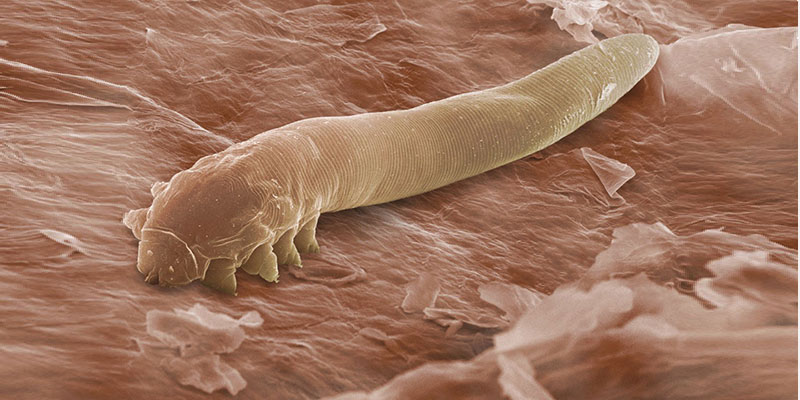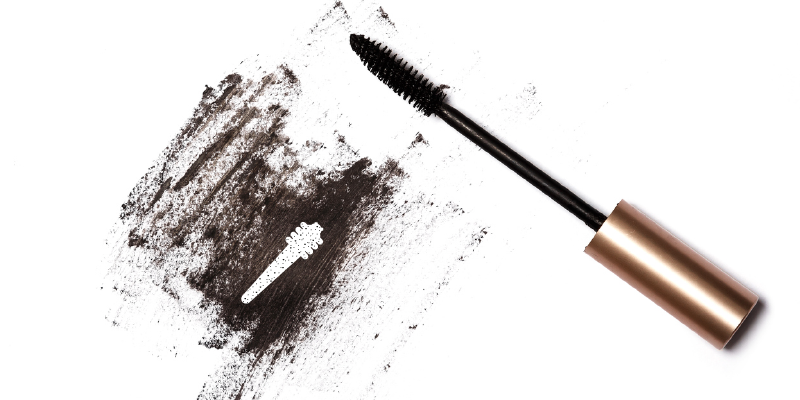Demodex is one of the billions of tiny organisms that are too small to see with the naked eye, which is probably a good thing, considering they are living on your skin and eyelashes right now. But not to worry—they’re supposed to be there, at least for the most part. It’s when an infestation happens that Demodex can start to cause problems for your eyes.
So what is Demodex, exactly, and what are they doing on your skin? Take a closer look at the two types of Demodex found on human skin and hair follicles and what you can do to get rid of them.
Demodex folliculorum

Of the two types of Demodex found on human skin, Demodex folliculorum is the most common. It is slightly larger than Demodex brevis and primarily inhabits the hair follicles, or roots of your eyelashes [1]. There, Demodex folliculorum eats cells that line the hair follicle. The problem, however, is that the mite’s waste material can become built up inside the hair follicle of your eyelashes, resulting in signs of blepharitis, such as dryness, redness, itching, sensitivity to light, loss of eyelashes, and crusty eyelashes and eyelids [2].
Demodex folliculorum can also carry harmful bacteria like Staphylococcus and Bacillus oleronius, which can result in serious infections [1].
Demodex brevis

Demodex brevis is very similar to demodex folliculorum, with the primary differences being that demodex brevis is smaller and it tends to inhabit the meibomian glands, rather than the hair follicles [1]. The meibomian glands are vertical structures located in both the upper and lower eyelids, and open at the base of the eyelashes [3]. Their primary function is to secrete an oily substance called meibum, which is made up of components like fatty acids, fatty alcohols, cholesterol, phospholipids, diglycerides, triglycerides and hydrocarbons [3]. This substance lubricates and protects the eyes, while also preventing tears from evaporating from the surface of the eye [3].
When there is an infestation of demodex brevis living within the meibomian glands, they can become clogged and therefore may result in an eye condition called meibomian gland dysfunction, or MGD. Signs of MGD can be similar to those of blepharitis and dry eye disease and usually include dryness, redness, itchiness and light sensitivity.
How to Get Rid of Demodex

Demodex doesn’t always cause eye problems. However, when these mites are present in abnormally large numbers, they can cause or contribute to eye conditions like blepharitis, dry eye disease, meibomian gland dysfunction, and ocular rosacea.
The good news is that by adopting the right eyelid cleansing routine, you can help to eliminate these bothersome mites fairly simply. The latest research has shown that the key to getting rid of Demodex mites is to use a cleansing product that contains isolated 4-Terpineol, one of the 15 compounds found in tea tree oil. 4-Terpineol has been shown to be the most efficient ingredient, even more so than pure tea tree oil, at eliminating Demodex mites [4].
Currently, Cliradex is the only commercially available product that isolates 4-Terpineol. You can use Cliradex wipes or Cliradex Light Foam once or twice daily to improve your eyelid hygiene and help to alleviate the symptoms of common eye conditions like blepharitis, dry eye, and MGD.
In Summary
If you’ve been having problems with dry, red, itchy eyes, you may need to talk to your eye doctor about a possible inflammatory eye condition, for which Demodex could be to blame. He or she should also be able to recommend the best treatment options, which typically include regular eyelid cleansing with a gentle product formulated to combat Demodex. Just be sure that the products you are using near your eyes are designed for use in the delicate eye area. Otherwise, you could unknowingly make matters worse.




